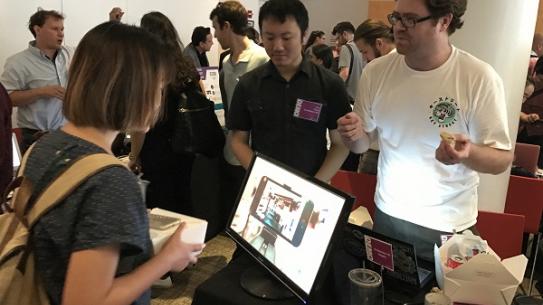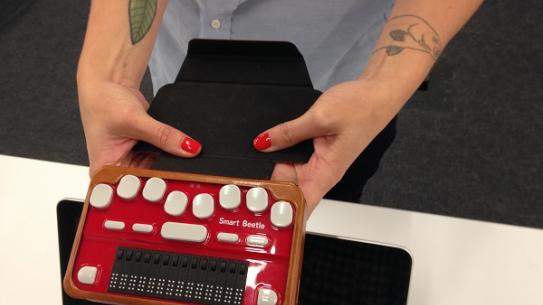Visionary VR/AR projects from Tandon community featured at NYC Media Lab Summit

At the NYC Media Lab Summit, attendees tested out NYU Tandon's Tandon Vision app — a mobile VR application that features trips to Mars and up-close views of bone cells.
With virtual and augmented reality (VR/AR) readily becoming the future of tech, NYU Tandon students are already forging ahead on that path. Their visionary projects, prototypes, and ideas were recently on display at the 2017 NYC Media Lab Summit, held at the New School on September 28.
Teams of students and faculty presented their work in VR/AR and digital media to crowds of tech professionals and insiders at the Summit, which hosted discussions and workshops with industry heavyweights, and spotlighted the digital media and new technology emerging from NYC universities during a prototyping showcase and demo expo.
Taking the stage during the data science prototyping showcase, members of the NYU Ability Project team discussed its interdisciplinary work within assistive and rehabilitative technologies, and their recent partnership with Charter Spectrum on digital accessibility. Students from Integrated Digital Media (IDM) and Ability Project research fellow Claire Kearney-Volpe shared with the audience their research and product development centered on humanizing and integrating accessibility within the home entertainment sector. (Read more about the Ability Project’s workshop on accessible digital design below).
NYU Tandon students presented dozens of projects in VR/AR and digital media at the 2017 Summit.

Dozens of projects from the NYU Tandon community were also featured at the Demo Expo. From Tandon Vision and its VR mobile app that travels to Mars, to the IDM-created HoloStudio that uses Microsoft Hololens to create a virtual artist studio, to EngageVR’s customizable VR learning experience for children with autism spectrum disorder, attendees gained a hands-on, or rather headsets-on, look at how students and faculty are translating VR/AR and other technologies for storytelling, improving health and wellness, transforming entertainment and the art world, and impacting society.
Relevant Motion, which counts IDM student Spencer Cappiello as its Experience Developer, combines virtual reality, motion capture, and occupational therapy to provide a cost-friendly, at-home physical therapy system. “While many people go to physical therapy at facilities with expensive equipment, they’re not doing exercises every day. We’re using bluetooth motion capture with Notch and Google Cardboard so you can see yourself and your movements, track your progress in real-time, and heal faster,” explained founder Todd Bryant, an adjunct professor with NYU Interactive Telecommunications Program.

NYU Tandon lecturer Mark Skwarek and NYU Tandon alum Yao Chen of Semblance AR demonstrated their mobile point-to-point navigation app that merges AR with a smartphone camera to guide users through various locales, such as an airport terminal or towards their seat at a concert venue. Semblance AR is also honing their real-time 3D streaming capabilities between mobile phones.
Multiple projects explored storytelling and world-making through AR, such as IDM graduate students Subigya Basnet and Vhalerie Lee’s Games of Thrones-inspired AR narrative experience, where the stories and castles of Westeros come to life on your phone. Basnet described their application’s potential to re-imagine other televisions shows or texts, such as children’s stories, through AR. Other storytelling projects included projects from IDM students, like Shuang Liang’s AR reading experience with the Sherlock Holmes’ tale The Sign of the Four, and Indira Ardolic’s Requeerium that merges a VR dreamscape with memories and stories from the queer community.
The NYC Media Lab also awarded a variety of student projects featured at the Demo Expo, including a team of NYU Tandon IDM students and alumni who earned a $1,000 prize for their project, Untitled Realities. In it, Najma Dawood-McCarthy, Gabriella Cammarata, and Chung-Fang Huang wrestle with the question of how virtual reality experiences can influence human identity formation.
Ability Project Facilitates Workshop on Accessible Digital Design
Claire Kearney-Volpe showed workshop attendees a braille display keyboard, an assistive technology device.

On September 29, workshops across Manhattan and Brooklyn were held as part of the NYC Media Lab’s 2017 Summit, including the Accessible Digital Design workshop hosted by the NYU Ability Project and the NYC Mayor’s Office for People with Disabilities.
Organized by Claire Kearney-Volpe, project manager and research fellow at The Ability Project, and Walei Sabry, Digital Accessibility Coordinator at the NYC Department of Information Technology and Telecommunication and Housing Coordinator at Office for People with Disabilities, the workshop kicked off with an interactive role-playing exercise Sabry called “experiencing inaccessibility.”
Emphasizing the daily experiences people with disabilities encounter, from inaccessible attitudes, to unlabeled online forms, to inaccessible websites or online videos, Sabry shared his interest in demonstrating “the physical, the social, and the personal part of inaccessibility.”
The workshop featured an overview of disability studies and history, as well as an introduction to technology like screen readers, braille readers, and accessibility features in Apple and Microsoft products. Attendees had a chance to test out screen reading navigation on laptop computers, while also learning key design and web development principles like audio description for videos, descriptive labeling of images, forms, and links, limiting usage of all capitals, or providing documents converted to readable text.
Kearney-Volpe highlighted the importance of creating devices, websites, and technology that incorporate universal and accessible design from the beginning, and to always keep the potential users in mind.
Camila Ryder
Graduate School of Arts and Science
Master of Arts in English Literature, Class of 2018




